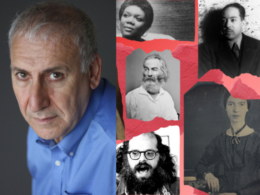Gender, joy, and worldbuilding in the University of Oregon’s Special Collections
By Sean Joyce-Farley
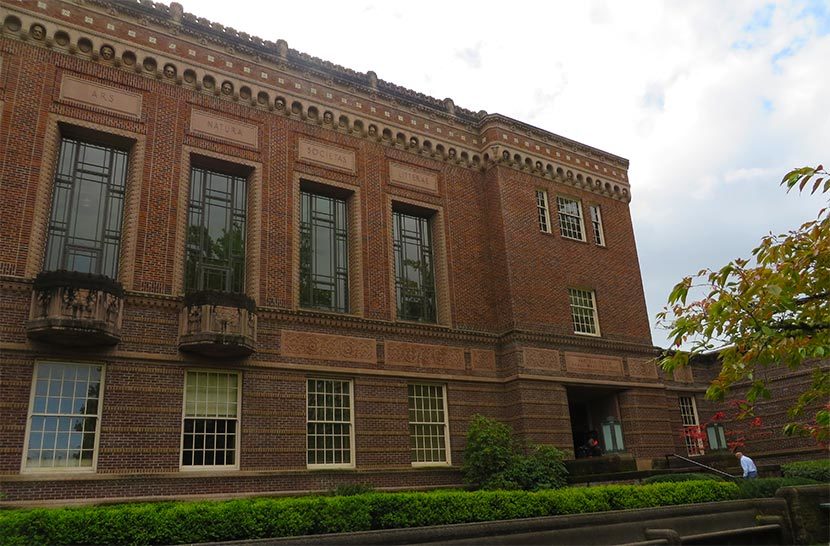
Knight Library lies tucked into the west side of the University of Oregon campus, just by the cemetery: a dark four-story brick building. Inside, sunlight falls into the Paulson Reading Room through the tall windows at my back. Rigged up in a mask, I look like a harbinger of things to come—but it’s the fall of 2019, and I just have a dust allergy.
There are no pens in the Special Collections, and no water. UO students periodically approach the desk only to learn that they need to take a different staircase to get to the other second floor, which is somehow not connected to this second floor. I take in camera, laptop, notebook, pencil. Grey boxes with my name on them—literally, stuck on in post-its—neatly line the shelf behind the librarian’s desk. The first box is number 77; inside, folders three to five house the handwritten manuscript of Ursula K. Le Guin’s The Left Hand of Darkness (1969). I lift up the lid, and let the light in.
The manuscript spans three notebooks. The first is a spiral composition book with a white cover, layered with black ink stamps of squiggle-filled squares and peace signs. Inside the company logo, dark strokes of pen pressed into the cardboard make a vortex of lines. From inside the vortex, a hand-drawn eye stares out.
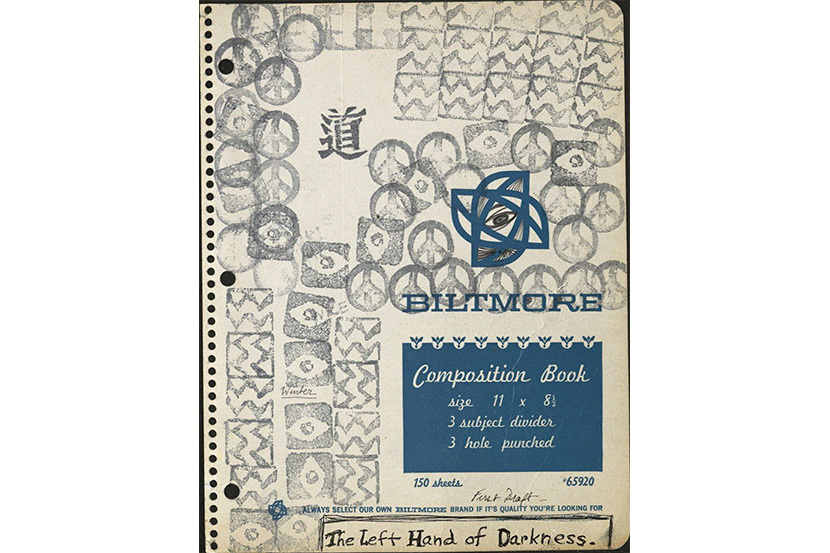
I worked as an editorial intern at Library of America in the summer of 2018. On my first day, Trish Hoard, the managing editor, had me insert some footnotes into chapters for a new volume which I believe is now LOA’s expanded edition of Le Guin’s 1985 novel Always Coming Home. I hadn’t read much science fiction in years, and I’d never read Le Guin; all I knew was that my little sister liked her. Two weeks later, Associate Editor Stefanie Peters got me onto the project of photocopying and compiling Le Guin’s poetry. The style and language were plain and direct, and not really to my taste. But here I was working on her collected poems, so I kept reading. And the more I read, the more strongly her voice resonated. So I started picking up her novels, too. Library of America’s Hainish Novels & Stories, Volume One conveniently put many of her early science fiction novels in one place for me. I read Rocannon’s World, a feudal–fantasy/science fiction adventure. Planet of Exile and City of Illusions, which were thrilling stories of what makes truth truth, and reality real. Then came The Left Hand of Darkness, which I read once, and then read again. Le Guin’s poetry faded into the background as her novels took me for an interstellar spin.
A year later, I’d only fallen further for Le Guin. In the spring, I proposed a project on her worldbuilding for my senior thesis. Project approved, and research generously funded by Smith’s Nancy Kershaw Tomlinson Fund, I flew to Oregon in mid-October. Airports feel a lifetime away to me now, living in pandemic-time, but then their strangeness had roots in other alienations.
The full-body scanners that the TSA uses at airports are a type called millimeter-wave scanners; they create an alternate-wavelength image of a person’s naked body. So says Wikipedia. When I left the East Coast, from a Hartford airport, I had my first encounter with millimeter-waves since I started hormone therapy.
Gender is a social phenomenon. In 1990, with Gender Trouble, Judith Butler broke theoretical ground on how gender is signaled and, in turn, interpreted, by all sorts of cues, all embedded in interpersonal interactions. Gender, Butler argued, is not merely defined by these codes: it’s created by them. Back to the airport. These kinds of scanners work by comparing each person’s scan to a normative male or female anatomy, so the operator of the machine presses a different button depending on the sex of the person entering it. Or really, the operator’s best guess. It’s how they pick who pats you down, too. Enter the machine, place your feet in the plastic guides, and lift your hands over your head. The scanner sweeps across. The machine makes an unhappy noise, and a man in uniform calls out, surprised and annoyed, “Are you a female?” People are often surprised, and often annoyed, when they guess wrong. Most people don’t like to be reminded that they’re guessing at all. Because what, then, makes the real real? Was I a man when I entered the machine, and a woman when I left it? And when I walked away—what then?
In The Left Hand of Darkness, Gethen is an ice-planet inhabited by people with no gender. Once a month, Gethenians go into kemmer, essentially a period of heat or estrus in which sex manifests. But sex is only sex. Outside of the kemmer period, Gethenian people have no latent desire. Sex is absent outside of kemmer: gender roles are nonexistent. Rape is nonexistent.

The Left Hand of Darkness is narrated mainly by a man from our Earth, Genly Ai, whose tale is as much a story of his constant gender crisis as it is one of diplomacy, imprisonment, and an epic quest across a glacier. On Gethen, Genly’s habit of reading gender cues becomes worse than useless, a hindrance. His perception of the world around him is muddled with failed acts of reading, looking for cues that aren’t there, and he often ends up confused. Throughout the novel, Genly refers to Gethenians with masculine language, even aside from pronoun use. There is a singular exception: Genly’s landlady. This “landlady” is the only person in the book he describes with a feminine title—others are kings, fishermen, etc.—and many critics have asked why. Genly says:
I thought of him as my landlady, for he had fat buttocks that wagged as he walked, and a soft fat face, and a prying, spying, ignoble, kindly nature.
He goes on,
He was so feminine in looks and manner that I once asked him how many children he had. He looked glum. He had never borne any. He had, however, sired four. It was one of the little jolts I was always getting.
This “jolt,” which comes very early on, is for me the key to the whole novel. A couple of chapters earlier, Genly says that he finds himself self-consciously trying to see a Gethenian “first as a man, then as a woman, forcing him into those categories so irrelevant to his nature and so essential to my own.” This self-reflection gives the reader some idea of the mental difficulty of perceiving people without gender, but it still relies on a masculine default. The landlady’s central importance in the novel’s depiction of androgyny is that Gethenians may also seem feminine, according to Genly’s gender cues. But—also key—this femininity exists only in Genly’s head. Le Guin doesn’t allow any equivalencies: feminine qualities aren’t reflected in any proclivity toward motherhood or particular social roles.
Now I can tell you why I mention this scene: when I visited the University of Oregon’s Special Collections, I found that in the original manuscript draft, there’s no “jolt” at all. Le Guin set up the same scene, but it went like this:
Trying to find out if his apparent femininity was a real tendency that would dominate during kemmer, I once asked him if he had borne children. He never had. He looked glum about it. Nor did he mention having sired a child, [and] he paid no visits to the Hearths or schools: so it may be that what I saw as femininity in him was actually deficient sexuality.
When I read this version in the manuscript, I almost blacked out. Maybe that’s dramatic. But if, in that moment, someone had shouted “FIRE!” I would probably have stayed in the building as it burned down around me. I hurriedly flipped to the same scene in the copy of the novel I’d brought in to the Collections, and stared at the change. The Left Hand of Darkness is a fascinating text to study for worldbuilding because so much of the worldbuilding happens on the level of consciousness: acts of social reading, like Genly’s perception of gender. But seeing this revision shifted something in me as a reader. Until this moment, my conception of worldbuilding posed Le Guin as an architect, and Gethen a monumental structure. It’s easy to get this impression from her novels. Her prose is incredibly tight, and the details of her worlds always meticulous. But here in this small scene was a defining moment which was made in revision. This particular site of revision speaks volumes: both that the initial impulse to bind female and defective together existed, and that this impulse was recognized and rejected, replaced by something much more interesting. The Left Hand of Darkness was criticized by contemporaries for its masculine defaults: the use of only he and him for Gethenians, the lack of any depictions of traditionally feminine work such as childcare, etc. But for me, this early moment in the book, this “jolt,” is where the real power of Gethenian androgyny lies: in Genly’s gender disorientation. I was floored by the fact that this potential was realized only in the process of revision, after a full draft of the novel was written. Only after writing a first draft could Le Guin recognize and re-write against the ingrained impulse to associate femininity with deficiency. And then, emphatically pairing the feminine landlady with masculine virility—not fertility!—she evokes an androgyny which is not something in-between, but something and and other.
In some of her own writing about the novel, Le Guin says of the Androgyne: “When one of the great myths moves, it is only by a movement of the whole person, intellect, feeling, sensation, intuition, that we can follow it. And we don’t know where it will lead us.”
Reading that manuscript, the word revision came apart. Visions and revisions. Consider Hélène Cixous’s “Laugh of the Medusa” (1975), in which she says of the woman writer:
Her language does not contain, it carries; it does not hold back, it makes possible.
Mornings, before the Collections opened at ten, I sat in my Airbnb, drinking instant coffee and reading N. K. Jemisin. I spent three and a half days reading and transcribing all I could from the manuscript, along with glimpses of Le Guin’s notes and correspondence. After they closed at four, I walked back to the house where I was staying to be greeted by a little grey cat, whose patience and quickness Le Guin would have had the right words to describe.
The archives were not a dream. In my dreamworld, Le Guin is a giant; in her notes she’s—well—woman-sized. The ice-planet Gethen is made real in page upon page of round handwriting, margin doodles of faces in profile, inky peace signs, and notes like “Rewrite This.” Throwaway notes in sprawling pencil reminded me of the day-to-day, the demands of a normal life. Writing from her 1975 trip to London, Le Guin easily conjures the essence of travel:
Main worry in mind now . . . Two hand bags and two suitcases, now filled with books, O idiot.
I read notebook pages she filled while driving across the country, counting every bridge, barn, and “bobcat (dead).” In all Le Guin’s work is this watchfulness of place and awe for the world, whether that means the sidewalks of Portland, the slopes of Mount St. Helens, or the massive plateau of Gethen’s Gobrin Glacier.
The Left Hand of Darkness awed me initially with its attention to the alien body, but after reading it a third time I was drawn also to its larger forms: forests of hemmens (red pine trees), fields of grain, massive ice-plains. She’s not alone among SF writers in foregrounding landscape—see Frank Herbert’s Dune. But, unlike Dune—in which the desert landscape’s greatest perils are tamed to serve the imperial ambition of the Atreides protagonist—Le Guin’s landscapes are consistently marked by a great indifference and sovereignty. The more I went on writing and thinking about The Left Hand of Darkness, the more I felt I left gender behind. Not forgetting the book’s androgyny, but integrating with it: gender came to feel as irrelevant to me, the reader, as it is to Genly’s landlady. Instead I felt a growing preoccupation with reading the landscape. That’s one of the things I think is neglected in scholarship on the novel, amid all the discussion of its imperfect Androgyne, mythic symbolism, and saturation with Taoism.
Le Guin is very often concerned with the sublime, with those feelings and connections that transcend language. You see it in her myth of the Androgyne, which Genly cannot describe, despite spending the novel trying. In the spirituality of the Handdara Foretellers, who see the future in a flash of light. You see it in the love between Genly and Estraven, when Genly says that after learning to communicate telepathically, the gulf between them only widened:
[T]hat intimacy of mind established between us was a bond, indeed, but an obscure and austere one, not so much admitting further light (as I had expected it to) as showing the extent of the darkness.
And of course the sublime is there in the trek across the Gobrin Glacier: again and again, in the ferocious and dazzling landscape, what Genly calls “that magnificent and unspeakable desolation.”
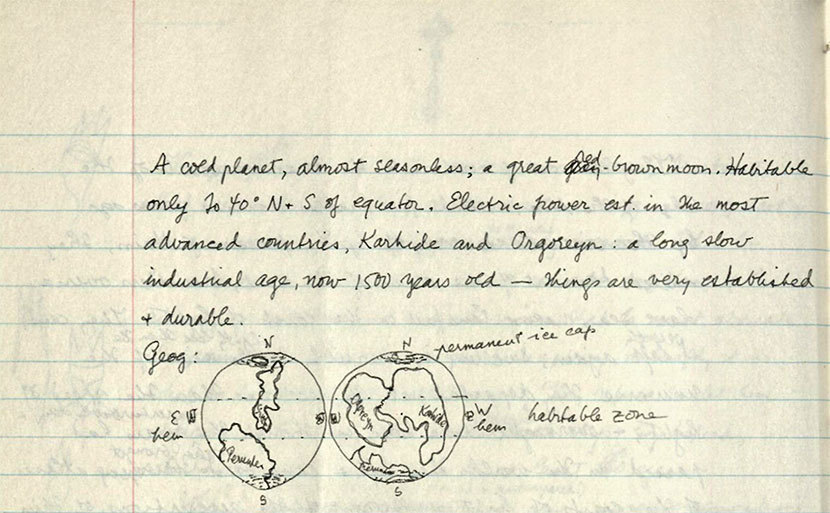
In the eighteenth chapter, “On the Ice,” Genly’s narrative shifts, for a few paragraphs, into the present tense. He recalls the dark, peaceful nights spent at rest in a tent on the Glacier as the center of his life: “that time which is past and lost and yet is permanent, the enduring moment.” He says,
I am not trying to say I was happy, during those weeks of hauling a sledge across an ice-sheet in the dead of winter. I was hungry, overstrained, and often anxious, and it all got worse the longer it went on. I certainly wasn’t happy. Happiness has to do with reason, and only reason earns it. What I was given was the thing you can’t earn, and can’t keep, and often don’t even recognize at the time; I mean joy.
Back in the travel notes from Le Guin’s trip to London, six years after The Left Hand of Darkness was published, she writes,
Going to sleep, a kind of peak, or half-mystical high [. . .] I think:
Fear, anxiety, grief,
sleep
the pure lines of the earth
I see it is all one: the “joy” as in Beethoven’s 9th, the long pure line, the melody, the earth, that comes out of and that is the fear, the anxiety, above all and centrally the grief . . . and don’t forget the sleep.
On the last leg of her return journey to Portland, she looks out to the world through the window:
To the left of the plane, Rainier, and then Mt St Helens, the rise and fall, the long pure line.
On my last day in Oregon, I rented a car and drove wester than west, toward an ocean I’d never seen. Route 26 rises up out of Portland and its heavy morning mist, out of the asphalt expanse, and narrows to a single shot through field and forest. The sun tracked behind me on the road and the forest loomed ahead, and then the road felt like just an alley cut through the pines, so fiercely tall and shadowed, and there I was plugging along, metal-belly-to-the-earth, as it climbed through the Tillamook and Clatsop State Forests.
I made it to the ocean. The beach was crowded, though it was overcast—and October. I heard of Cannon Beach back in the LOA office, reading Going Out with Peacocks and Other Poems (1994), one of Le Guin’s many poetry volumes. On page seventeen you’ll find “Sun Setting at Cannon Beach”:
It makes this loud noise.
This great light shines.
That old tree stands to break the light in two.
I need a new tongue.
My old tongue breaks in two
knowing the left word and the right word
but not the loud word of ocean
or the great light word.
I didn’t see the sun set. In fact, I didn’t see much of the sun at all in that grey sky. But I had come for the loud word, which was there in the long pure line of the horizon, broken by two towers of black rock rising out of the water. I set my backpack down on the sand, rolled my pants up, walked out into the skirts of waves that came flaring out. And listened.
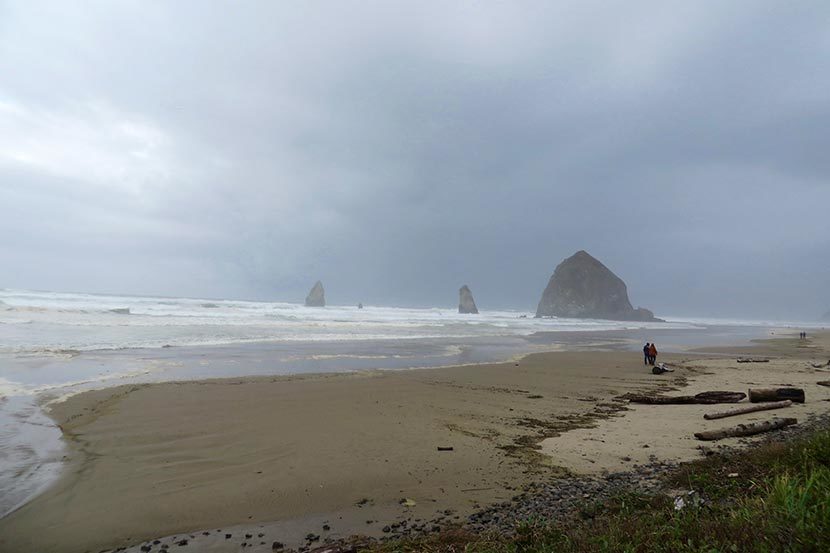
Genly gets lost on Gethen, a planet of ice and red-needled pines. In the novel’s darkest moment, he winds up in prison, where he almost dies. On his deathbed, he trades folktales and stories with an older fellow-prisoner named Asra. Asra is the only character who ever uses an endearment for Genly; he calls him “child.” When Genly tells Asra of a world where there are people in constant kemmer—constant sex—Asra asks:
“Is it a place of reward, then? Or a place of punishment?”
“I don’t know, Asra. Which is this world?”
“Neither, child. This here is just the world, that’s how it is . . .”
Despairing, Genly says, “I wasn’t born into it. I came to it. I chose it.” After a moment, Asra replies, “Ah well . . . We none of us choose.” In a way, Asra makes Genly a Gethenian. He tells Genly stories as a mother would, and in this exchange he gives Genly permission to think of Gethen as his world, too. Genly finds love with Estraven, but I think it is with Asra that he finds a new tongue.
I found in the Special Collections that the best moments of the book weren’t pulled from the ether; they were plotted out in Le Guin’s tireless hand, crossed out, and revised, in slanting lines that bled into the margins. I saw worldbuilding in a totally new way, fluid and freewheeling, like playing or dancing. It was world-in-creation.
| *Read The Left Hand of Darkness in* |
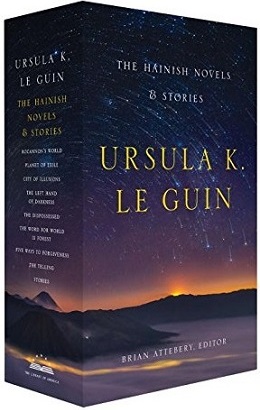 |
| Ursula K. Le Guin: The Hainish Novels & Stories (boxed set) |
I have been thinking, lately, of worldbuilding in a more expansive context. It’s what we do every day, after all, even those of us who aren’t science fiction authors. Worldbuilding is in every story we tell, to others and to ourselves, in every way we read, and in all the language we use to construct our reality/ies. And imagining the future, in the midst of a pandemic and civil unrest, is too a matter of writing and rewriting. I began this article in March, shortly before the spread of COVID-19 across the United States brought so much change to all our lives. I write now at the end of June, as the death toll in this country rises past 120,000. How is this relevant to Le Guin? It isn’t, totally, except that I love Le Guin and I live in this new reality, which consists in large part of rage and fear. Except that Le Guin’s work always demands that we consider which stories we tell and how we tell them. Consider power and consider freedom. Consider the horror of Genly’s imprisonment and illness, the relief of his escape, and now consider the lives of over two million people imprisoned and detained in the United States. I went to vote in my congressional district primary today, and leaving I used a pump of NYS Clean hand sanitizer: a product made by prisoners in New York State for next to nothing, who themselves are denied access to hand sanitizer due to its alcohol content. Le Guin’s work is often about considering language as a vehicle of power, its equal potential to breach and reinforce the domination of white supremacy and capitalism. Right now, I can’t write about Le Guin’s language without thinking of how the language of power uses the passive voice to write about police officers using “less lethal” weapons against protesters. Current injustices are relevant to reading Le Guin because reading Le Guin is always to be asked to consider how worlds are made, and with what language.
The Left Hand of Darkness, like many of Le Guin’s works, relies on a central relationship between two characters. Le Guin called this common theme marriage. Its centrality means that even in stories of pain, confusion, and struggle, there is always a foundation of love, intimacy, and mutual care. Fear, anxiety, grief, sleep: joy. Genly and Estraven cross an ice-planet’s largest glacier, in the dead of winter, to stop the beginning of a planet’s first war. We none of us choose this world. We all can imagine a new one. At the Special Collections, from a notebook labelled “1981,” I transcribed a passage which has echoes of one of her later books of essays, Dancing at the Edge of the World (1989):
“World-making” —
Making a new world —
Making a world new —
Or the making of the world. This world. This mundane world. The world that is new every morning, [and] every new year’s day, [and] at the birth of every baby.
That we “make” the world we inhabit is unquestionable, whether we make it all from scratch, or by a more or less judicious selection of what is useful or entertaining from the eternal chaos of the real. [. . .]
[. . .] And a fragment of a dance song —
Dancing on the brink of the world . . .
With these fragments we have shared our ruin. You need a past to make a future with. To make a new world you start with an old one. To find a world maybe you have to be lost. Maybe you have to stand on the brink of the world in order to dance.
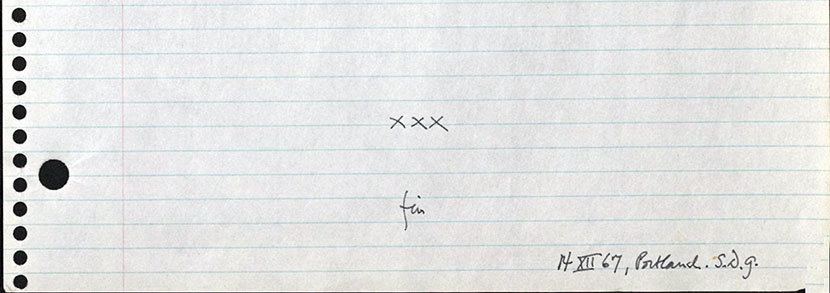
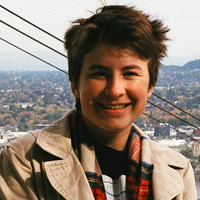
Sean Joyce-Farley is a former Library of America intern and recent graduate of Smith College. They blog at crocussed.wordpress.com.



